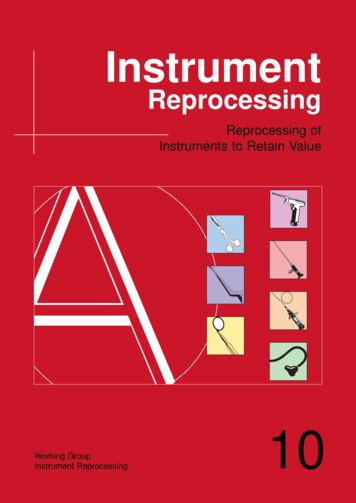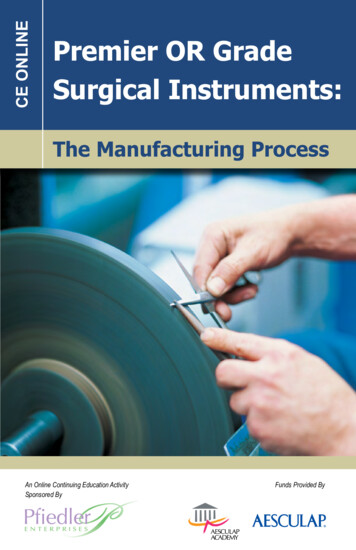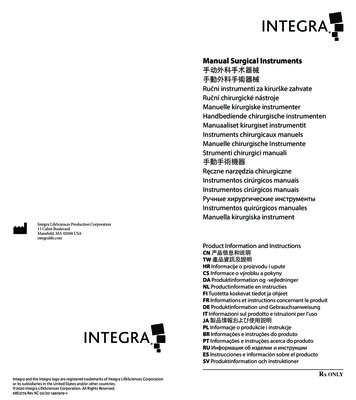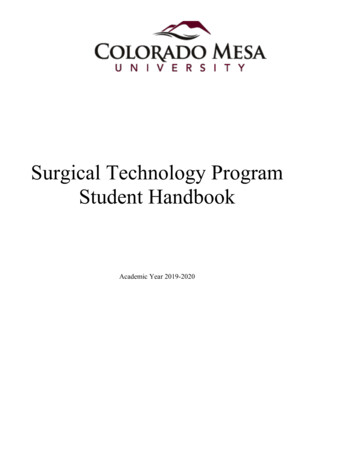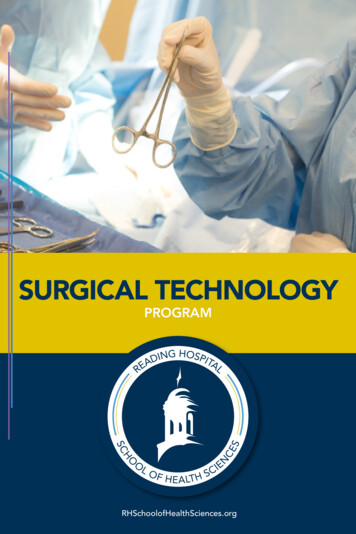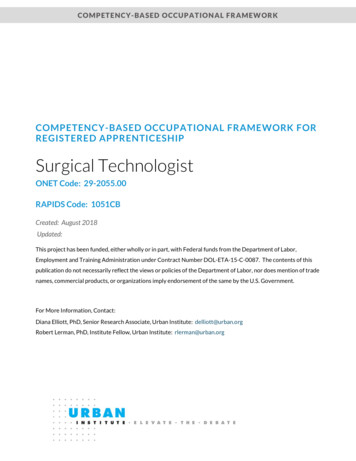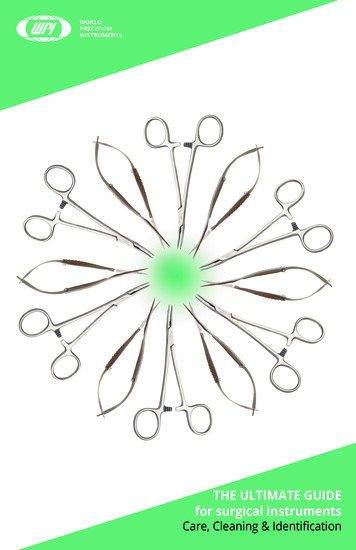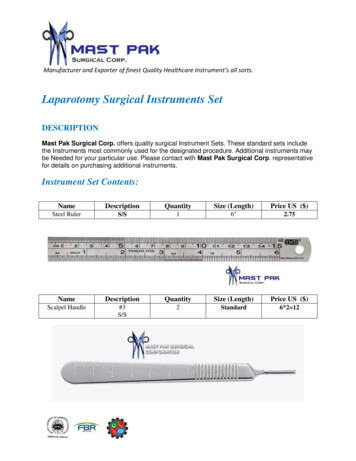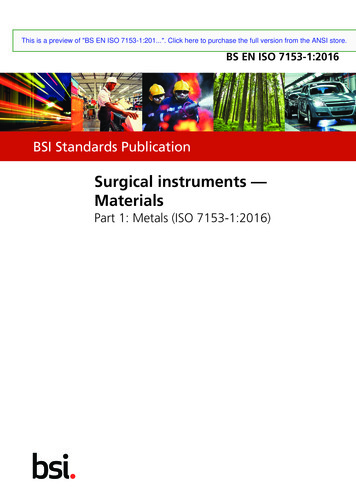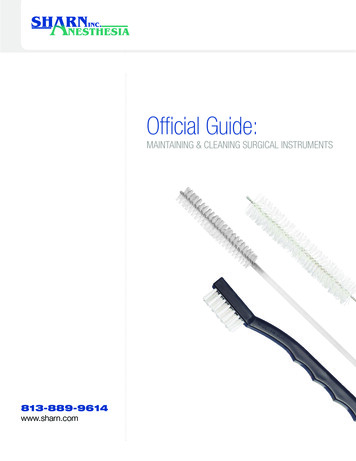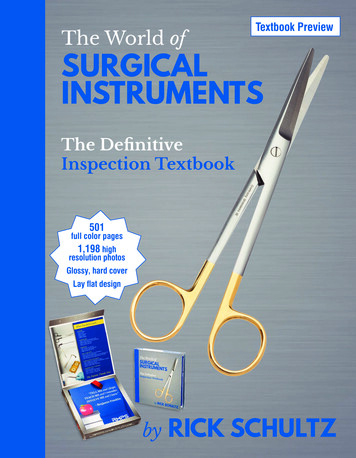
Transcription
The World ofTextbook PreviewSURGICALINSTRUMENTSThe DefinitiveInspection Textbook501full color pages1,198 highresolution photosGlossy, hard coverLay flat designbyRICK SCHULTZ
SCISSORSFrequently Asked QuestionsQ: Do all scissors go dull?A: Yes. Every scissor goes dull no matter what size, specialty, manufacturer, or design.Q: Does sterilization dull a scissor?A: Generally, no. However, when old autoclaves produce dirty steam, the scissor bladeedges can become stained, which can cause the scissor not to cut.Q: Can all scissors be resharpened?A: Yes. Every scissor can be resharpened. Make sure the repair vendor is properlytrained, especially on SuperCut scissors (black-handled).Q: How often should scissors be tested?A: Scissors should be tested 1 to 2 times per week. The proactive approach is picking2 days per week as scissor testing days. Using an instrument tracking system willallow the facility to track sharpening frequency. Eventually, a large percentage ofscissors will be sharp.Q: Is the scissor testing standard red and yellow scissor test material?A: Yes. The industry standard is to use red scissor test material for scissors longer than41 2" in overall length and yellow scissor test material for scissors that measure 41 2"and shorter. Yellow scissor test material is used on 41 2" scissors.Q: Do all repair technicians know how to sharpen scissors?A: No. Experience and proper training is key, and many times repair technicians arelearning on your expensive instrument inventory. The hospital should verify howmany months of training/employment the repair technician has. On average, arepair technician needs 9 to 12 months of training. This training should not beperformed on the facility’s inventory of instruments. You cannot teach experience.Q: Is it true that certain scissors need to be sharpened more often?A: Yes. The black-handled SuperCut scissor needs to be sharpened the most(quarterly) because it has a knife edge.Q: Can scissors be over-sharpened?A: Yes. Scissors can be over-sharpened by inexperienced repair technicians. Only sendout dull scissors for resharpening. Not all scissors in a set need to be sharpened.Q: Can serrated scissors be sharpened?A: Yes. The repair technician should know how to sharpen a serratedscissor. But remember, experience cannot be taught. An inexperiencedrepair technician may not know the correct method.Q: Do all black-handled scissors have a serrated edge?A: No. Black-handled SuperCut scissors have the option of serrated edgesor not. One serrated blade and one knife blade is the most popularconfiguration.Q: Should gold-handled scissors be sharpened more often?A: No. Gold-handled scissors stay sharper longer. They should first betested before sending them out for sharpening.Q: What is the reason tungsten carbide is used in scissors?Diagram of a blackhandled scissorSerrated edgeKnife edge
SCISSORSMayo Scissor, Tungsten CarbideInstrument Name: Mayo Scissor, Tungsten CarbideAlso Known As: Gold MayoSimilar Instruments with Same Inspection: All scissorsOverall Length: 51 2" (14 cm), 63 4" (17.1 cm), 9" (22.9 cm), straight or curvedInstrument Use: Cutting non-delicate tissue/tougher tissue (cartilage/tendons)Tray Assembly Tip: Sterilize with rings slightly openSharpness Test Standard: Red scissor test materialTips shouldbe rounded.Inspect both bladesfor cracks and dents.Inspect seamsfor pitting.Inspect forcracks onboth sides.Separate the rings andinspect for blood andtissue on both sides.Open and close rings.Cutting action shouldbe smooth.Inspectseamsfor pitting.Inspect for separationof metal.Inspectblades forcracks.
NEEDLE HOLDERSMayo-Hegar Needle Holder,Tungsten Carbide Jaws and Standard JawsInstrument Name: Mayo-Hegar Needle Holder, Tungsten Carbide Jaws and Standard JawsAlso Known As: Needle driverSimilar Instruments with Same Inspection: All other needle holdersOverall Length: 7" (17.8 cm)Instrument Use: Driving suture needles in the suturing processTray Assembly Tip: Sterilize with ratchets in the open positionTungsten carbide jaws. Much harder metal thanstainless steel. The jaw tread wears outvery slowly. Jaws lastlonger. Grips the suture needlebetter. When the jaws wearout, the repair vendorcan simply replace. Tungsten carbide isindicated by 24-karatgold rings.JawsStandard stainless jaws.Once these jaws wear out,the instrument cannot berejawed and must be replaced.Box lockShanksRingsTread wear area.Tungsten carbide jaw.Stainless steel jaw.Jaw Tread WearTungsten Carbide JawAcceptableNot acceptable
NEEDLE HOLDERSTypes of Needle HoldersClosed positionOlsen- en gar,HegarTungsten Standard,CarbidenoncarbideOpen positionOlsen- HeaneyHegar
LAPAROSCOPICFrequently Asked QuestionsQ: There is a space between the insulation and the tipof the instrument. Is this okay?A: No. The instrument must be immediately removed from serviceand sent out for repair. A gap can allow blood and fluids toenter under the insulation. If the abdomen is insufflated, it willcause the blood to be forced under the insulation.Insulation“pull test”Gap in insulationHow is loose laparoscopic insulation visuallyQ:tested?A: To test the insulation visually, inspect the entire shaft for any nicksor cuts. Next, lightly pull back on the insulation. If the insulation slidesback, the instrument is in need of re-insulation.Q: What is the port near the handle used for?Proper Flushing and IrrigationWith the distal tip underwater, connectsyringe to irrigation port and draw upwater from cleaning sink. Force cleaningfluids in and out of shaft.A: This port is used to flush the instrument during the cleaning process.Q: Where are the most difficult areas to clean on a laparoscopicinstrument?A: The most challenging areas to clean are the jaws and distal workingportion (linkage). This is where blood and fluids can hide. Manualcleaning and the use of an ultrasonic irrigator will assist in cleaningthese areas.Q: How are laparoscopic scissors tested for sharpness?A: Unless stated differently in the Instructions For Use (IFU), laparoscopicscissors are tested on one thickness of gift wrap tissue paper or yellowscissor test material.Q: How is the jaw tension tested on laparoscopic graspers?A: Gently clamp a lint-free towel with the laparoscopic grasper and pull back.The grasper should not slip from the towel.Q: What methods can be used to prevent damage to the tips oflaparoscopic instruments?A: Using a tip protector will help protect sharp tips and delicate instrumentsfrom damage or place instruments in a secure instrument rack and tray.
LAPAROSCOPICLaparoscopic Claw Forcep, 10 mmInstrument Name: Laparoscopic Claw Forcep, 10 mmAlso Known As: Claw grasper, Clickline Similar Instruments with Same Inspection: All three-piece laparoscopic grasping forcepsOverall Length: Shaft: 36 cm, 43 cmWidth: Diameter: 5 mm, 10 mmInstrument Use: Grasping tissue during minimally invasive proceduresInspect teeth forblood and tissue.Drive rod/insert.Inspect collar forsecure fit. Thereshould be no gap.Flushing mayassist duringthe cleaning Inspect post forprocess.bends/damage. Inspect handlefor cracks.Outershaft/tube.*Inspect formissing/torninsulation.Proper sizebrush mayassist withcleaning.Inspect forcracks onboth sides.*Inspect formissing/torninsulation.Handle.Press toremovedrive rod.Rotating knobshould moveleft and right.Laparoscopic ClawForcep, DisassembledLaparoscopic ClawForcep, Assembled*Insulation testing may assist in locatingpin holes which are usually not visible.
HEMOSTATIC/RING-HANDLED FORCEPSKelly ForcepInstrument Name: Kelly ForcepAlso Known As: Snaps (often confused with Rochester Pean)Similar Instruments with Same Inspection: All hemostatsOverall Length: 51 2" (14 cm), half serrated jawsInstrument Use: Clamping off vesselsTray Assembly Tip: Sterilize with ratchets in the open positionInspect both jaws for dents.Inspect serrations for bloodand tissue.Tips should meetevenly with no overlap.Separate the rings and inspect forblood and tissue on both sides.Crile forcephas fullyserratedjaws.Inspectboth jawsfor bloodand tissue.Inspect for cracks onboth sides.Kelly forcephas halfserratedjaws.Test ratchet. Verify itlocks in each position.Dr. Howard Atwood Kelly (1858-1943)Credited with establishing gynecology as a specialty by developingnew surgical approaches to GYN diseases. One of the founders ofJohns Hopkins University School of Medicine (Baltimore, MD,1893)
HEMOSTATIC/RING-HANDLED FORCEPSMost Common hsner(Kocher)
UROLOGYResectoscopeInstrument Name: ResectoscopeAlso Known As: Bipolar resectoscope, Urology resectoscopeInstrument Use: Removal or biopsy of lesions of the bladder, prostate, or urethraTray Assembly Tip: Very delicate instrument. A protection case may reduce damage.Resectoscope, assembledVerify connectionis secure.Proper size brush mayassist with cleaning.Inspect for benthandles/levers.Inspect for crackson both sides.Color indicatesthe diameter ofthe sheath. Yellowindicates 26French (Fr.)Connection shouldbe secure.Color indicatesscope degree.Red indicates 30º.Inspect ceramic tipfor cracks and chips.Inspect holes forblood and tissue.Inspect for dents.Open and closetesting springtension.
CARE AND HANDLINGDamaged Laparoscopic SpatulaCause: The insulation may have been damaged during use. Over time, the insulationmay become brittle and chip off.Effect: The insulation is torn/missing. The instrument should be removed from serviceimmediately and sent for repair. Continued use may result in the insulationdropping into the surgical site and cause a significant patient risk.Prevention:use.This instrument requires visual inspection and insulation testing after everyTorn insulation. REMOVEFROM SERVICEIMMEDIATELY AND SENDOUT FOR REPAIR.
The World ofSURGICAL INSTRUMENTSThe Definitive Inspection TextbookTestimonials“It is the Encyclopedia Britannica for surgical instruments. The picture-in-picturedetail is awesome to show proper inspection points.” - B.C.R., North Carolina“Nothing short of being the go-to resource for instrument knowledge and care andhandling for the novice and expert.” - R.W.S., MBA, CRCST, CIS, CHL, Ohio“The textbook even provides an unprecedented, behind the scenes look intoinstrument repair and maintenance. Rick’s new book is a home run and a must readfor Sterile Processing professionals.” - J.P., BSN, RN, CCSVP, CMRP, Pennsylvania“An outstanding instructional guide. I would have loved to have such a work whenI started 37 years ago!” – J.M.E, PhD, OhioAbout The Book»»»»»»501 pages with 1,198 high resolution photosHardcover “lay flat” hidden spiral binding70 lb super white paper with 20 section tabsFAQ’s for each sectionIncludes Surgical Instrument Repair and How to Measure sectionsAuthored by multiple award-winning surgical instrument expert, Rick SchultzHOW TO ORDER:www.RICKSCHULTZ.orgFOR QUESTIONS: sales@rickschultz.org or call 330-714-9088
Effect: The insulation is torn/missing. The instrument should be removed from service immediately and sent for repair. Continued use may result in the insulation dropping into the surgical site and cause a significant patient risk. Prevention: This instrument requires visual inspection
